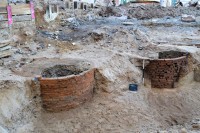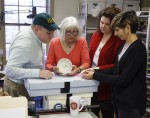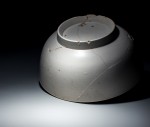The Chinese figured out how to make hard-paste or true porcelain, the finest ceramic known for its hardness and translucency, in the 7th century. It would take almost another thousand years, in the 16th century under the Ming Dynasty, for fine Chinese porcelain to be exported to Europe in significant quantities. There it was admired and puzzled over. European ceramicists tried to crack the code — the combination and quantity of raw materials, the firing temperature — but failed. Only in the 18th century did Johann Friedrich Böttger, at the behest of Augustus II the Strong, Elector of Saxony, solve the mystery of hard-paste porcelain. The Meissen factory, founded in 1710, was the first European producer.
 That wasn’t the end of the story, however. In the American colonies, particularly in the southern states, experimentation with porcelain took off in the 1730s, and continued for decades. There is documentary evidence of the study and eventual production of China in America, but no actual evidence of 18th century hard-paste porcelain in the archaeological record. The excavations at the site of the new Museum of the American Revolution in Philadelphia in 2014 finally found that evidence.
That wasn’t the end of the story, however. In the American colonies, particularly in the southern states, experimentation with porcelain took off in the 1730s, and continued for decades. There is documentary evidence of the study and eventual production of China in America, but no actual evidence of 18th century hard-paste porcelain in the archaeological record. The excavations at the site of the new Museum of the American Revolution in Philadelphia in 2014 finally found that evidence.
The survey of the museum site has proven to be one of the greatest archaeological bonanzas in American history, and so deliciously on topic to the institution that will open in historic downtown Philadelphia on April 19th, 2017. The behind-the-scenes hero of the piece is, yet again, poop. Archaeologists unearthed 12 brick-lined outhouse vaults packed with artifacts from the first decade of the 18th century through the mid-19th century. Private residents, shops and hostelries all used the privies as trash cans as well as toilets for 150 years or so, leaving 21st century archaeologists almost 85,000 artifacts to sort through.
 One of the 85,000 is a small white punch bowl, unearthed in fragments in 2014. Archaeologists from Commonwealth Heritage Group initially thought the bowl was a piece of white stoneware, but a recent material analysis by Saint Mary’s University geologist Dr. J. Victor Owen, an expert on archaeological ceramics and glass, found that the bowl is true-porcelain, probably manufactured in Philadelphia.
One of the 85,000 is a small white punch bowl, unearthed in fragments in 2014. Archaeologists from Commonwealth Heritage Group initially thought the bowl was a piece of white stoneware, but a recent material analysis by Saint Mary’s University geologist Dr. J. Victor Owen, an expert on archaeological ceramics and glass, found that the bowl is true-porcelain, probably manufactured in Philadelphia.
“One of the most intriguing stories in the world of ceramic history is the search for the secrets of making hard-paste porcelain,” said Robert Hunter, editor of Ceramics in America and an author and archaeologist. “The search, however, for physical evidence of making true porcelain in 18th century America has been frustratingly unsuccessful – until now. The discovery of this bowl is like finding the holy grail of American ceramics, and is a thrilling addition to the history of the American effort to produce this coveted material.”
It also has direct relevance to the theme of the Museum of the American Revolution, because buying domestic, even for luxury goods, was a political statement in the lead-up to the Revolution.
“The discovery of this remarkable little bowl reminds us that the ‘buy local’ movement has very deep roots in American history,” said Dr. R. Scott Stephenson, Vice President of Collections, Exhibitions, and Programming at the Museum of the American Revolution. “It is also an important reminder that when colonists boycotted imported British goods as a way to protest Parliamentary taxation, they did not have to settle for crude versions of beloved luxuries from abroad. Colonial tradespeople produced elegant textiles and ceramics for a market eager use the ‘power of the purse’ to make a political point.”
 A report on the discovery and analysis of the punch bowl will be published in the January issue of Ceramics in America. The little broken white Holy Grail will go on permanent display in the “homespun” gallery of the new museum when it opens this Spring, but will make its first public appearance at the New York Ceramics and Glass Fair this month. Co-author of the article Robert Hunter will be giving a lecture at the fair on the quest to make true porcelain in 1700s America and how the Philadelphia punch bowl fits into that history on Thursday, January 19th.
A report on the discovery and analysis of the punch bowl will be published in the January issue of Ceramics in America. The little broken white Holy Grail will go on permanent display in the “homespun” gallery of the new museum when it opens this Spring, but will make its first public appearance at the New York Ceramics and Glass Fair this month. Co-author of the article Robert Hunter will be giving a lecture at the fair on the quest to make true porcelain in 1700s America and how the Philadelphia punch bowl fits into that history on Thursday, January 19th.
I always find it amazing that anything is found intact. But to me it more amazing that we accept the dating methods for something like this, but for a lot of people around the world, the same dating methods must be flawed when it comes to the Dinosaurs. Its our duty not only to record the past, but protect it from those who want to destroy due to religious intolerance.
Ok. Sounds fascinating, but they said ‘probably’ manufactured in Philadelphia. Good have it have been possibly made overseas? What proof is there that it was made in the colonies?
I would guess that the composition of the clay would say more definitively as well as the style. Although so called luxury goods were made in the colonies the makers tended to put a local spin on things. That’s just a guess based on what the re-enactors have go go through to find something that is “right” or “correct ” for their gear.
Valerie!
Say it with me fifty times … I Love Autocorrect!
That was Valete not Valerie. She will laugh when I tell her though.
The new museum will be at 101 S. Third St. The Curtis Building is on Walnut Street between Sixth and Seventh. So enjoy some terrific artifacts (including Washington’s tent from Valley Forge) and then take a short stroll for a look at Tiffany’s The Dream Garden.
Yay! Another poop story!
Do you have any idea if it was an economic advantage to buy local in the Revolutionary era? Was a porcelain bowl from England cheaper than one from Philadelphia, the way a bowl from China today costs a fraction of what I would pay a local potter? Or given the expenses of 18th-century transport, was it cheaper to buy locally made luxury goods?
So funny how many important items we find in old latrines, pits, and outhouses. Sometimes, when I see a really old abandoned mansion out in the middle of nowhere, I want to go and dig around the outhouse and the foundations!
Archaeologists will one day find the flashlight I accidentally dropped down the latrine at Boy Scout camp circa 1965. While the batteries lasted it provided quite the spectacle.